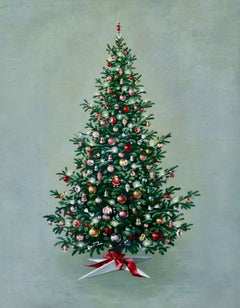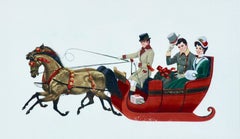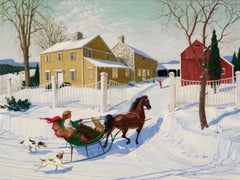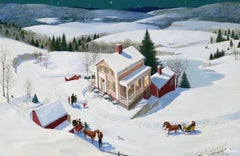Egg Tempera Paintings
to
6
6
5
1
6
Overall Height
to
Overall Width
to
4
3
2
2
2
2
2
2
2
2
2
1
1
1
1
1
1
1
1
1
6
2
2
1
8
18
13
9
9
7
6
6
6
4
Artist: Charlotte Sternberg
Medium: Egg Tempera
Harvest Time
Located in Fort Washington, PA
Medium: Egg Tempera on Illustration Board
Signature: Signed Lower Right
Greenwich Village Workshop
Category
1980s Egg Tempera Paintings
Materials
Illustration Board, Egg Tempera
Christmas Tree
Located in Fort Washington, PA
Medium: Egg Tempera on Gesso Panel
Signature: Unsigned
Category
1960s Egg Tempera Paintings
Materials
Egg Tempera, Gesso, Panel
Vanderbilt Sleigh
Located in Fort Washington, PA
Medium: Egg Tempera on Illustration Board
Signature: Unsigned
Category
1950s Egg Tempera Paintings
Materials
Illustration Board, Egg Tempera
Tree in Weathered Niche
Located in Fort Washington, PA
Medium: Egg Tempera on Illustration Board
Category
1960s Egg Tempera Paintings
Materials
Illustration Board, Egg Tempera
Chasing the Sleigh
Located in Fort Washington, PA
Medium: Egg Tempera on Illustration Board
Signature: Unsigned
Category
1950s Egg Tempera Paintings
Materials
Illustration Board, Egg Tempera
House at an Angle
Located in Fort Washington, PA
Medium: Egg Tempera on Gesso Board
Category
20th Century Egg Tempera Paintings
Materials
Egg Tempera, Gesso, Board
Related Items
White and Purple Dahlias Floral Still Life in Oil on Linen on Illustration Board
Located in Soquel, CA
White and Purple Dahlias - Floral Still Life in Oil on Illustration Board
Delicate still life of dahlias in a green vase by Gertrud Stimming ...
Category
1940s Impressionist Egg Tempera Paintings
Materials
Oil, Linen, Illustration Board
H 26.75 in W 23 in D 1.25 in
Virgin of Kataphyge and St. John, after a Byzantine Bulgarian Icon 14th Century
Located in Segovia, ES
The Virgin of Kataphyge with Saint John the Evangelist, after a Bulgarian Byzantine icon of the 14th Century.
Egg tempera and gold leaf on gesso and wood.
Author: Oliver Samsinger...
Category
Early 1900s Byzantine Egg Tempera Paintings
Materials
Gold Leaf
H 15.36 in W 10.63 in D 0.99 in
'Story Time', Paris, Salon d'Automne, New York, ASL, Corcoran, PAFA, Art Deco
By Nura Ulreich
Located in Santa Cruz, CA
Signed lower left 'Nura' for Nura Woodson Ulreich (American, 1899–1950). Additionally signed, verso, dated March 1928 with artist's New York City ...
Category
1920s Surrealist Egg Tempera Paintings
Materials
Oil, Illustration Board
H 20 in W 16 in D 0.25 in
Icon of Our Lady of Jerusalem with oklad by Oliver Samsinger
Located in Segovia, ES
Icon of Our Lady of Jerusalem.
Egg tempera on gesso and over a wooden board.
Dimensions in centimeters: 42 x 34 x 2 cm / In inches: 16.54 x 13-39 x 0-79 "
Author: Oliver Samsinger...
Category
1990s Byzantine Egg Tempera Paintings
Materials
Brass
H 16.54 in W 13.39 in D 0.79 in
Christ, the Great High Priest. Greek-Italian style Icon with silver oklad
Located in Segovia, ES
Christ, the Great High Priest. Greek-Italian style Icon with silver filigreed oklad.
Egg tempera, over gesso on wood with a silver cover, "oklad", with pol...
Category
1990s Byzantine Egg Tempera Paintings
Materials
Silver
H 21.26 in W 15.36 in D 0.79 in
Large Japanese Wood Board Ema Namban Depicting a Portuguese Ship Edo period
Located in Stockholm, SE
An Ema is a votive plaque people hang in a "dedication area", at a Shinto shrine, with their wish to the gods. Wishes usually would revolve around health, love, career, prosperity, a...
Category
Mid-19th Century Realist Egg Tempera Paintings
Materials
Wood, Tempera, Egg Tempera, Wood Panel
Mid-Century Floral Still Life with Yellow and White Irises Carmel California
By Alvira Powell
Located in Soquel, CA
Mid-Century Floral Still Life with Yellow and White Irises
Gorgeous mid-century floral still life of a bouquet of Irises painted in 1959, by Pacific Grove and Santa Cruz, Californi...
Category
1950s American Impressionist Egg Tempera Paintings
Materials
Canvas, Oil, Illustration Board
H 23.75 in W 20.5 in D 1.25 in
The Virgin of Tijvin (after a Russian Icon in the style of the 18th century).
Located in Segovia, ES
The Virgin of Tijvin (after a Russian icon in the style of the 18th Century).
Egg tempera and gold leaf on gesso over wood.
Measurements in centimeters: 45 x 36.5 x 3 cm / In inch...
Category
1990s Byzantine Egg Tempera Paintings
Materials
Gold Leaf
H 17.72 in W 14.38 in D 1.19 in
Christ Pantocrator" After an Icon in the style of the Moscow School
Located in Segovia, ES
"Christ Pantocrator". After an Icon in the style of the Moscow school (15th century). Somewhat similar to that of Rublev.
Author: Oliver Samsinguer
Egg tempera and gold leaf on gesso and on wood.
Dimensions; (H) 42 x (W) 33.5 x (D) 3.5 cm.
(H) 16.54 x (W) 13.19 x (D) 1.38 in.
This is how the artist sums up the technique used by him to create the icon:
“The aim of these steps is to create a durable painting. The icon is eternal.
The first step is to choose a support, traditionally made of wood, from the center of the trunk to avoid warping it. For this purpose, two hardwood bolts were often used on the back to give the picture panel additional stability.
Often a frame is milled out. Then the image carrier is sanded smooth and now 12 or 14 thin layers of gesso are applied and sanded smooth as well.
Then the preliminary drawing is applied and the drawing board is prepared with a special preparation called bolus. This bolus can be polished to a high gloss. Afterwards, the gold leaf is
"shot" with special brushes. It dries up within a few hours and can now be polished with an agate. Gold leaf is real 24-carat gold .
Now, the actual process of painting begins. Egg tempera is made fresh from egg yolk, water, and a little vinegar. This is used to prepare the color pigments.
Tempera painting is done in numerous layers from dark to light.
When the icon is finished, it is left to dry for a few months and varnished with a special varnish called Olifa made from boiled linseed oil and other ingredients”.
ABOUT THE ARTIST
Oliver Samsinger...
Category
1990s Byzantine Egg Tempera Paintings
Materials
Gold Leaf
H 16.54 in W 13.19 in D 1.38 in
Pikes Peak, 1940s Colorado Mountain Landscape in Autumn, Tempera Painting
Located in Denver, CO
Original vintage 1941 Colorado landscape painting with autumn leaves and Pikes Peak blanketed in snow by Charles Bunnell (1897-1968). Inscribed verso, "To Laura, November 22, 1941", egg tempera on board. Signed by the artist in the lower left corner and titled verso. Presented in a custom frame, outer dimensions measure 15 ½ x 19 ¼ x 1 ¼ inches. Image size is 7 ¾ x 11 inches
About the Artist:
Artist and teacher, Charles ("Charlie") Bunnell worked in a variety of styles throughout his career because as an artist he believed, "I’ve got to paint a thousand different ways. I don’t paint any one way." At different times he did representational landscapes while concurrently involved with semi- or completely abstract imagery. He was one of a relatively small number of artists in Colorado successfully incorporating into their work the new trends emanating from New York and Europe after World War II. During his lifetime he generally did not attract a great deal of critical attention from museums, critics and academia. However, he personally experienced a highpoint in his career when Katherine Kuh, curator at the Art Institute of Chicago, personally chose one of his paintings - Why? - for its large exhibition of several hundred examples of abstract and surrealist art held in 1947-48, subsequently including it among the fifty pieces selected for a traveling show to ten other American museums.
An only child, Bunnell developed his love of art at a young age through frequent drawing and political cartooning. In high school he was interested in baseball and golf and also was the tennis champion for Westport High School in Kansas City. Following graduation, his father moved the family to Denver, Colorado, in 1916 for a better-paying bookkeeping job, before relocating the following year to Colorado Springs to work for local businessman, Edmond C. van Diest, President of the Western Public Service Company and the Colorado Concrete Company. Bunnell would spend almost all of his adult life in Colorado Springs.
In 1918 he enlisted in the United States Army, serving in the 62nd Infantry Regiment through the end of World War I. Returning home with a 10% disability, he joined the Zebulon Pike Post No. 1 of the Disabled American Veterans Association and in 1921 used the benefits from his disability to attend a class in commercial art design conducted under a government program in Colorado Springs. The following year he transferred to the Broadmoor Art Academy (founded in 1919) where he studied with William Potter and in 1923 with Birger Sandzén. Sandzén’s influence is reflected in Bunnell’s untitled Colorado landscape (1925) with a bright blue-rose palette.
For several years thereafter Bunnell worked independently until returning to the Broadmoor Art Academy to study in 1927-28 with Ernest Lawson, who previously taught at the Kansas City Art Institute where Bunnell himself later taught in the summers of 1929-1930 and in 1940-41. Lawson, a landscapist and colorist, was known for his early twentieth-century connection with "The Eight" in New York, a group of forward-looking painters including Robert Henri and John Sloan whose subject matter combined a modernist style with urban-based realism. Bunnell, who won first-place awards in Lawson’s landscapes classes at the Academy, was promoted to his assistant instructor for the figure classes in the 1928-29 winter term. Lawson, who painted in what New York critic James Huneker termed a "crushed jewel" technique, enjoyed additional recognition as a member of the Committee on Foreign Exhibits that helped organize the landmark New York Armory Exhibition in 1913 in which Lawson showed and which introduced European avant-garde art to the American public.
As noted in his 1964 interview for the Archives of American Art in Washington, DC, Bunnell learned the most about his teacher’s use of color by talking with him about it over Scotch as his assistant instructor. "Believe me," Bunnell later said, "[Ernie] knew color, one of the few Americans that did." His association with Lawson resulted in local scenes of Pikes Peak, Eleven Mile Canyon, the Gold Cycle Mine near Colorado City and other similar sites, employing built up pigments that allowed the surfaces of his canvases to shimmer with color and light. (Eleven Mile Canyon was shown in the annual juried show at the Carnegie Institute in Pittsburgh in 1928, an early recognition of his talent outside of Colorado.) At the same time, he animated his scenes of Colorado Springs locales by defining the image shapes with color and line as demonstrated in Contrasts (1929). Included in the Midwestern Artists’ Exhibition in Kansas City in 1929, it earned him the gold medal of the Kansas City Art Institute, auguring his career as a professional artist.
In the 1930s Bunnell used the oil, watercolor and lithography media to create a mini-genre of Colorado’s old mining towns and mills, subject matter spurned by many local artists at the time in favor of grand mountain scenery. In contrast to his earlier images, these newer ones - both daytime and nocturnal -- such as Blue Bird Mine essentially are form studies. The conical, square and rectangular shapes of the buildings and other structures are placed in the stark, undulating terrain of the mountains and valleys devoid of any vegetation or human presence. In the mid-1930s he also used the same approach in his monochromatic lithographs titled Evolution, Late Evening, K.C. (Kansas City) and The Mill, continuing it into the next decade with his oil painting, Pikes Peak (1942).
During the early 1930s he studied for a time with Boardman Robinson, director of the Broadmoor Art Academy and its successor institution, the Colorado Springs Fine Arts Center from 1930 to 1947. In 1934 Robinson gave him the mural commission under the Public Works of Art Project (PWAP) for West Junior High School in Colorado Springs, his first involvement in one of several New Deal art...
Category
1930s American Impressionist Egg Tempera Paintings
Materials
Egg Tempera, Board
H 15.5 in W 19.25 in D 1.25 in
Saint Nicolas in the style of Russian icons of the 18th century. With Oklad
Located in Segovia, ES
Icono of Saint Nicolas in the style of Russian icons of the 18th century.
Egg tempera and gesso on wood, covered by a metal oklad made by the artist himself. The oklad, in principle, were made to cover damaged parts of highly revered ancient icons...
Category
1990s Byzantine Egg Tempera Paintings
Materials
Gesso, Wood, Egg Tempera
H 11.82 in W 10.04 in D 0.79 in
Study for a Fish at Sea with Three Flags-Ink, egg-tempera and gold leaf on panel
Located in Dallas, TX
Konstantinos Papamichalopoulos was born in Athens, Greece in 1975. He studied painting and printmaking at the Athens School of Fine Arts, where he also received a postgraduate degree...
Category
2010s Contemporary Egg Tempera Paintings
Materials
Gold Leaf
H 7.88 in W 15.75 in D 1.19 in
Previously Available Items
Christmas Florist
Located in Fort Washington, PA
Medium: Egg Tempera on Illustration Board
Signature: Signed Lower Right
Category
1990s Egg Tempera Paintings
Materials
Illustration Board, Egg Tempera
Egg Tempera paintings for sale on 1stDibs.
Find a wide variety of authentic Egg Tempera paintings available on 1stDibs. While artists have worked in this medium across a range of time periods, art made with this material during the 21st Century is especially popular. If you’re looking to add paintings created with this material to introduce a provocative pop of color and texture to an otherwise neutral space in your home, the works available on 1stDibs include elements of blue, orange, purple, green and other colors. There are many well-known artists whose body of work includes ceramic sculptures. Popular artists on 1stDibs associated with pieces like this include Fides Becker, Barnaby Fitzgerald, Charlotte Sternberg, and Catherine Koenig. Frequently made by artists working in the Contemporary, Modern, all of these pieces for sale are unique and many will draw the attention of guests in your home. Not every interior allows for large Egg Tempera paintings, so small editions measuring 0.1 inches across are also available
Recently Viewed
View AllMore Ways To Browse
Old Master Picture
Mid Century Modern Paris Oil Painting
Grand Villa
Siam Signed
Exhibit Poster Framed
Swedish 20th Century Painting
Albert Green
Dutch Modern Painter
Dior India
Mid Century Horse Painting
Midcentury Modern Gouache Paintings
Architectural Drawings Of Interiors
Original Childrens Illustration
Surreal Italian
Native American Warror
Painting With Oval Frame
Woman In A Red Dress
Miniature House







